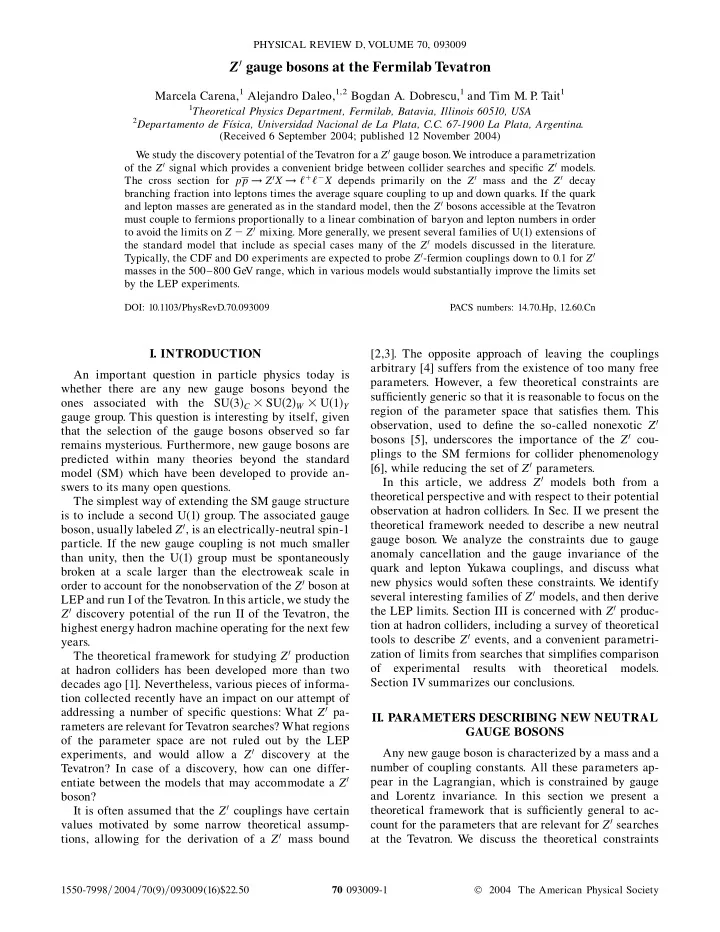

PHYSICAL REVIEW D, VOLUME 70, 093009 Z 0 gauge bosons at the Fermilab Tevatron Marcela Carena, 1 Alejandro Daleo, 1,2 Bogdan A. Dobrescu, 1 and Tim M. P . Tait 1 1 Theoretical Physics Department, Fermilab, Batavia, Illinois 60510, USA 2 Departamento de Fı ´sica, Universidad Nacional de La Plata, C.C. 67-1900 La Plata, Argentina. (Received 6 September 2004; published 12 November 2004) We study the discovery potential of the Tevatron for a Z 0 gauge boson.We introduce a parametrization of the Z 0 signal which provides a convenient bridge between collider searches and specific Z 0 models. The cross section for pp ! Z 0 X ! ‘ � ‘ � X depends primarily on the Z 0 mass and the Z 0 decay branching fraction into leptons times the average square coupling to up and down quarks. If the quark and lepton masses are generated as in the standard model, then the Z 0 bosons accessible at the Tevatron must couple to fermions proportionally to a linear combination of baryon and lepton numbers in order to avoid the limits on Z � Z 0 mixing. More generally, we present several families of U(1) extensions of the standard model that include as special cases many of the Z 0 models discussed in the literature. Typically, the CDF and D0 experiments are expected to probe Z 0 -fermion couplings down to 0.1 for Z 0 masses in the 500–800 GeV range, which in various models would substantially improve the limits set by the LEP experiments. DOI: 10.1103/PhysRevD.70.093009 PACS numbers: 14.70.Hp, 12.60.Cn I. INTRODUCTION [2,3]. The opposite approach of leaving the couplings arbitrary [4] suffers from the existence of too many free An important question in particle physics today is parameters. However, a few theoretical constraints are whether there are any new gauge bosons beyond the sufficiently generic so that it is reasonable to focus on the SU � 3 � C � SU � 2 � W � U � 1 � Y ones associated with the region of the parameter space that satisfies them. This gauge group. This question is interesting by itself, given observation, used to define the so-called nonexotic Z 0 that the selection of the gauge bosons observed so far bosons [5], underscores the importance of the Z 0 cou- remains mysterious. Furthermore, new gauge bosons are plings to the SM fermions for collider phenomenology predicted within many theories beyond the standard [6], while reducing the set of Z 0 parameters. model (SM) which have been developed to provide an- In this article, we address Z 0 models both from a swers to its many open questions. theoretical perspective and with respect to their potential The simplest way of extending the SM gauge structure observation at hadron colliders. In Sec. II we present the is to include a second U(1) group. The associated gauge theoretical framework needed to describe a new neutral boson, usually labeled Z 0 , is an electrically-neutral spin-1 gauge boson. We analyze the constraints due to gauge particle. If the new gauge coupling is not much smaller anomaly cancellation and the gauge invariance of the than unity, then the U(1) group must be spontaneously quark and lepton Y ukawa couplings, and discuss what broken at a scale larger than the electroweak scale in order to account for the nonobservation of the Z 0 boson at new physics would soften these constraints. We identify several interesting families of Z 0 models, and then derive LEP and run I of theTevatron. In this article, we study the the LEP limits. Section III is concerned with Z 0 produc- Z 0 discovery potential of the run II of the Tevatron, the tion at hadron colliders, including a survey of theoretical highest energy hadron machine operating for the next few tools to describe Z 0 events, and a convenient parametri- years. The theoretical framework for studying Z 0 production zation of limits from searches that simplifies comparison of experimental results with theoretical models. at hadron colliders has been developed more than two Section IV summarizes our conclusions. decades ago [1]. Nevertheless, various pieces of informa- tion collected recently have an impact on our attempt of addressing a number of specific questions: What Z 0 pa- II. PARAMETERS DESCRIBING NEW NEUTRAL rameters are relevant for Tevatron searches? What regions GAUGE BOSONS of the parameter space are not ruled out by the LEP experiments, and would allow a Z 0 discovery at the Any new gauge boson is characterized by a mass and a number of coupling constants. All these parameters ap- Tevatron? In case of a discovery, how can one differ- entiate between the models that may accommodate a Z 0 pear in the Lagrangian, which is constrained by gauge boson? and Lorentz invariance. In this section we present a It is often assumed that the Z 0 couplings have certain theoretical framework that is sufficiently general to ac- count for the parameters that are relevant for Z 0 searches values motivated by some narrow theoretical assump- tions, allowing for the derivation of a Z 0 mass bound at the Tevatron. We discuss the theoretical constraints 1550-7998 = 2004 = 70(9) = 093009(16)$22.50 70 093009-1 2004 The American Physical Society
Recommend
More recommend